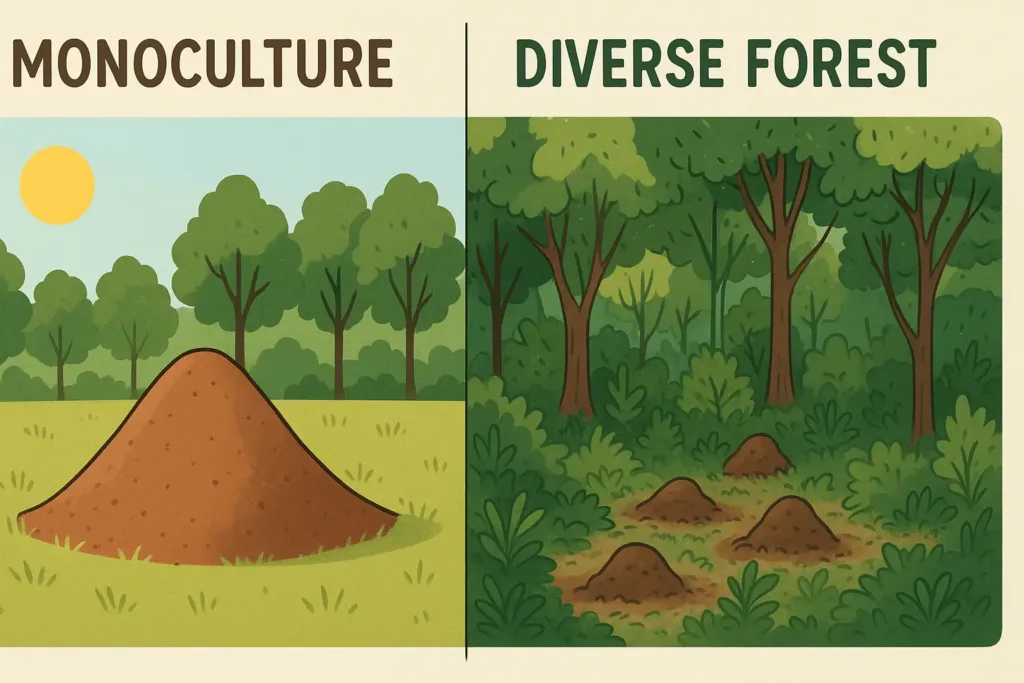Red imported fire ants pose a significant threat to agriculture and wildlife. They invade and damage farms and crops and harm wildlife. These ants have spread rapidly in many areas, and they are very difficult to control. Yet, there is a natural solution, and that is tree diversity. Instead, we would plant different tree species, so the landscape itself is difficult for these ants.
Red imported fire ants came from South America. They came to other countries in ships and cargo. Now, they are spreading rapidly. These ants are aggressive and can sting people or animals. They can deliver stings that can be painful and cause allergies. They also damage crops, bite livestock, and disturb local wildlife.
The nests can also damage electrical equipment and farm machinery. You want to manage it effectively. How can we do this without those harmful chemicals? Reducing their impact is a natural and effective way provided by the diversity of trees.
How Tree Diversity Helps Control Red Imported Fire Ants
Red imported fire ants (RIFA) have become one of the most destructive invasive species worldwide, causing billions of dollars in damage annually. These aggressive insects don’t just sting – they destroy crops, damage infrastructure, and disrupt entire ecosystems. However, recent research shows that there is a powerful natural solution hiding in plain sight: tree diversity. When forests and landscapes maintain a rich variety of tree species, they create complex ecosystems that naturally suppress fire ant populations through a number of interconnected mechanisms.
Understanding how tree diversity controls red imported fire ants offers hope for sustainable, cost-effective management strategies. Instead of relying solely on expensive chemical treatments, we can harness nature’s own defense systems to fight these invasive insects.

Economic & Agricultural Impacts of RIFA
The financial impact of red imported fire ants goes far beyond their painful stings. These invasive insects have gone from a regional nuisance to a global economic disaster, affecting multiple sectors simultaneously.
RIFA’s economic damage stems from several key areas:
- Agricultural Losses: They directly damage crops, especially young plants and fruits, causing significant yield losses. They also prey on beneficial insects and pollinators, disrupting entire ecosystems.
- Infrastructure Damage: Fire ants are notorious for nesting in electrical equipment, from air conditioning units and traffic lights to utility boxes. Their nests can cause short circuits, power outages, and equipment malfunctions, leading to costly repairs and service disruptions.
- Harm to Livestock: These ants can swarm and kill newborn calves, chickens, and other small animals. Their stings can also blind large livestock, reducing their value and productivity.
- Control Costs: Homeowners, farmers, and municipalities spend enormous amounts of money each year on pesticides and insecticides to control infestations, a cost that is often recurring and unsustainable.
Mechanisms: How Tree Diversity Suppresses RIFA
Tree diversity doesn’t just create beautiful landscapes—it establishes complex ecological networks that actively combat ant attacks through a variety of sophisticated mechanisms.
1. Habitat Complexity and Structural Interference
The diverse forest canopy creates complex three-dimensional environments that disrupt fire ant colony establishment and expansion. Mixed tree species create different canopy densities, creating irregular light patterns that interfere with fire ants’ navigation and foraging behaviors.
The root systems of different tree species occupy distinct soil layers and create underground barriers. These complex root networks fragment potential nesting sites, making it difficult for fire ants to establish the large, interconnected colonies they prefer.
Leaf litter from diverse tree species creates contrasting ground conditions. Some trees produce allelopathic compounds—natural chemicals that inhibit fire ants’ survival. When multiple tree species contribute different leaf chemistries, the combined effect creates hostile microenvironments for fire ant larvae and queens.
2. Increased Predator and Competitor Populations
A diverse range of trees supports a wide variety of wildlife, including natural predators of fire ants. Spiders, birds, lizards and other insectivorous species all thrive in different habitats and help keep fire ant populations in check. A diverse ecosystem also supports a wide array of native ant species that compete with RIFA for food and nesting sites. This natural competition prevents any one species from dominating the landscape.
3. Disruption of Colonies
In a diverse forest, thick, layered leaf litter and varying canopy cover disrupt fire ant colonies. RIFA prefer to nest in areas with direct sunlight. The shade provided by the mixed canopy and the constant temperature fluctuations and soil moisture from decaying leaves make it difficult for them to regulate the temperature of the mound. This is a key factor in their colony’s survival, as illustrated by the diagram below showing the optimal conditions for a RIFA mound.

Case Studies and Examples
Data collected from around the world supports the link between biodiversity and fire ant control.
- Australia: The continent faces an estimated A$45 billion in losses over the next few decades if the spread of RIFA is not controlled. The country is seeking large-scale, sustainable solutions to combat this invasive threat, including the re-establishment of native plant species and diverse forests.
- Hawaii & US South: These regions have been battling fire ants for decades, with ongoing losses to agriculture and significant public health concerns from painful stings. The problem is often most severe in human-modified landscapes and monocultures, highlighting the need for changes in land management practices.
- Native Range (Argentina): In their native South American habitat, red imported fire ants are one of many ant species. The region’s rich biodiversity — along with a complex web of predators, competitors, and diseases — keeps RIFA populations in check. They coexist rather than dominate, a clear example of nature’s balance in action.
For a more detailed look at this particular relationship, the book Red Imported Fire Ants: Attacking Everything offers an excellent deep dive into these ecological dynamics.
Practical Tips for Planting Diverse Trees to Control Red Imported Fire Ants

But to use a diversity of trees to control fire ants, you have to figure out which trees to plant. Native trees are often the best. Predators of the fire ants live there. Local people are attracted to them because they attract local wildlife. They also support the natural food chain.
Here are some tree species that are useful:
- Oak trees: These offer shelter and food for a variety of birds and animals that eat ants.
- Pine trees: Most ants don’t like pine needle habitat.
- Cypress trees: Ants find it difficult to form colonies in wetlands where these trees grow.
- Fruit trees: Some fruit trees attract insects and birds, which will take care of the ant population.
As with planting for variety, spread the trees out a bit like people locations. The best thing to do is mix different species together. This is so the ants have to cross more obstacles and compete with other ants. Additionally, try to plant in places where red imported fire ants are most active. This helps prevent their spread.
A Natural Solution for an Invasive Problem
In our area, red imported fire ants are a dangerous and growing threat. Tree diversity offers a simple, natural solution. Planting a variety of species does two important things. It will attract natural predators. It creates barriers and reduces competition for food. Furthermore, it helps deal with imported fire ants without the use of harmful chemicals. It is beneficial not only for the season but for the entire ecosystem. In the long run, increased tree diversity makes the ecosystem more resilient to pests in general.
Once we show tree diversity, we understand that nature has its own way of creating balance. So it works, and it’s an ecological solution we should adopt.
Conclusion
Tree diversity is not just a forest luxury—it’s nature’s own defense against some of our most destructive pests. By embracing diverse landscapes and planting a mix of native trees, we can create resilient ecosystems that naturally control imported red fire ants and reduce our reliance on chemical treatments. This approach offers a sustainable, long-term solution that benefits both the environment and our economies.
We encourage researchers, landowners, and readers to support biodiversity efforts and share these insights. By working together, we can protect our lands, our crops, and our communities from this ongoing threat.
Recommended Reads For Curious Minds
- The Hidden Life of Trees by Peter Wohlleben
- Bringing Nature Home by Douglas Tallamy
- The Garden Awakening by Marry Reynolds
Frequently Asked Questions
Yes, red imported fire ants are harmful to both people and the environment. Their painful stings can cause allergic reactions, while large infestations disrupt local ecosystems by driving out native insects. They also damage crops, soil, and even electrical equipment, making them a serious pest.
Technically, fire ants don’t bite – they grab with their jaws and then sting using venom. The sting usually feels like a sharp burning sensation, followed by itching or small blisters that look like white pimples. For most people, this is painful but temporary. However, some people experience severe allergic reactions that require immediate medical attention.
They spread aggressively, form massive colonies, and outcompete native ants. Beyond ecological damage, they pose risks to humans, pets, and livestock through painful stings. Economically, they cost billions worldwide in agricultural losses, medical treatments, and pest control efforts.
Red imported fire ants are native to South America. They were accidentally introduced to the United States in the 1930s through shipping cargo that arrived in Mobile, Alabama. From there, they spread rapidly across the southern states due to favorable climate and lack of natural predators.
Complete eradication is difficult, but control is possible. Methods include:
1. Boiling water treatments for small mounds.
2. Baits with insect growth regulators that target the colony over time.
3. Biological controls like phorid flies in research-based approaches.
4. Maintaining healthy, diverse vegetation can also reduce infestations naturally.




